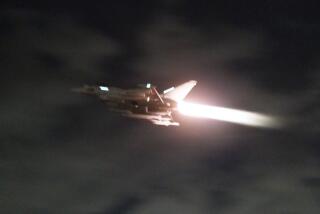Allied Troops Feel a Chill in the Desert
CAMP THUNDER, Kuwait — On their first full day at this camp still being carved out of the desert, the men and women of the 9th Battalion drew a step closer Tuesday to the realities of modern combat.
“Gas! Gas!” a sergeant hollered, and suddenly everyone was scrambling to pull on awkward chemical-biological warfare suits and gas masks in the stifling midday heat.
Minutes earlier, someone had screamed “Scud!” and soldiers were piling, heads down and shoulders hunched, into trenches dug into the baked desert sand.
There was a sharper edge Tuesday to the actions of a quarter-million U.S. and British troops arrayed across the Persian Gulf region. Here with the 101st Airborne in northern Kuwait, with Marine platoons in the desert nearby and on aircraft carriers trolling the waters offshore, everyone moved a bit faster and with greater purpose, knowing that the president of the United States had brought them closer to war.
Coming only a few hours after President Bush issued a 48-hour ultimatum to Iraqi President Saddam Hussein, drills such as this one at sparse Camp Thunder brought home the dangers that lie ahead. Troops elsewhere were breaking camp and moving farther west or farther north toward the Kuwaiti border with Iraq, ahead of what would be a long march into enemy territory.
“We have a greater sense of urgency today,” said the 9th Battalion commander, Lt. Col. Timothy A. Jones, his brown T-shirt drenched in sweat that dripped from his nose and chin after an hour in a gas mask and protective suit.
“We’re always training to be ready,” Jones said, “but this 48-hour deadline has given us additional focus.”
Earlier Tuesday, before dawn, with a full moon hanging above the horizon, soldiers from Company C of the 4th Battalion, 64th Armored Regiment of the 3rd Infantry Division, began breaking camp, tearing down the tents that had housed their three platoons and cramming their gear onto the decks of M1-A1 Abrams tanks that will now serve as their homes.
Ammunition was handed out, and fuel trucks arrived to form a train that will follow the tanks north to an undisclosed location closer to the border, where they will join the remainder of their brigade for what is expected to be a long haul into central Iraq to confront Hussein’s Republican Guard.
Spare Accommodations
For what could be just a few days or several weeks, four-man crews (there are no female tankers here) will live in the approximate space of a washing machine carton, sleeping outside on the tank’s deck and turret, or on the wind-scoured sand.
In their preparations Tuesday, the soldiers squeezed and economized.
Drivers in the tanks’ isolated front compartment, little bigger than a subcompact’s rear hatch, stuffed every unused space with chewing gum, cigarettes, snacks, water bottles and caffeinated beverages to keep them from dozing off on the reclined seat.
It would be the last day for the three plywood latrines and the despised detail of burning their contents twice daily. Gone as well were the breakfast and dinner visits by the chow truck.
In heat that reached nearly 100 degrees, crews cleaned the tanks’ 50-caliber machine guns, changed filters for the jet-turbine engines, then ducked under the shadows cast by the tank turrets, watching Black Hawk helicopters and A-6 Warthog tank-killing aircraft shimmer past on low-flying practice sorties.
Higher-flying aircraft, lost in the glare of the desert sky, ripped across the heavens, their distant sound like a massive ball bearing on a wood floor.
The troops reviewed and rehearsed an intricate battle plan on a 50-foot-square patch of sand, with water bottles arranged in sinuous lines to depict the Euphrates and Tigris rivers, and arrows drawn with string.
Over at Camp Matilda, headquarters of the 30,000-strong 1st Marine Division, anticipation and tension that have gripped the men and women for weeks appeared to dissipate with the order to move out.
“It’s kind of a relief to know that something is finally going to happen,” said Cpl. Quanah Striker, 21, of Hemlock, Mich., as Marines loaded gear and equipment. “This is a step closer to getting me home.”
“I think any human being would feel what I’m feeling now: some fear of the unknown,” said 24-year-old Sgt. Christopher Raczkowski of Grand Rapids, Mich.
Before the mass movement, each Marine received a letter from Maj. Gen. James Mattis, commander of the division. Marines packed copies of the letter in their packs.
“On your young shoulders rests the fate of mankind,” the general wrote.
And as America moved toward war, there was renewed apprehension about what moves a cornered Iraqi regime might make.
Iraqi forces Tuesday flushed at least 50 small vessels from the Tigris River outflow into the northern Persian Gulf, sparking fears of an attack on U.S. warships by an explosives-laden boat, Rear Adm. John M. Kelly, commander of naval forces in the region, told reporters aboard the aircraft carrier Abraham Lincoln.
U.S. officials have warned that the Baghdad regime could try to unleash an eleventh-hour attack on American air, ground or naval forces. The Iraqis have also been observed moving among known cruise missile launchpads on the narrow peninsula between the gulf and the Tigris.
“This game could begin any time,” Kelly warned.
“There’s a potential increase in the risk that Iraqi forces will start a conflict, take a shot at us,” Kelly said aboard the aircraft carrier that is his flagship. “We’ve had that risk, but it’s more real today than in the past.”
Iraqi forces overnight swept at least 50 dhows out into the Khawr abd Allah Channel into the gulf, he said. U.S. and other allied vessels were trying to stop and search each of the dhows -- used for fishing, smuggling and occasionally as cover for terrorist missions such as the blast that damaged the U.S. destroyer Cole in 2000.
Few things make the looming danger as palpable as the rubbery chemical warfare suit that troops have to pull on, or the hard gas masks that suck on their faces.
Back at the 9th Battalion, where the gas attack drills seemed to galvanize troops who until now had enjoyed a comparatively unhurried existence, soldiers squatted in trenches and discussed imaginary Scuds descending on them.
When the 20-minute Scud exercise was over, heads popped up at the tops of the trenches. Minutes later, huffing and lurching inside their chemical-biological suits, the troops and officers endured an hourlong “full MOPP 4” -- a complete mission-oriented protective posture alert. At Level 4, the highest, troops must put on protective suits, goggles, gloves and boots.
The enormity of chemical or biological warfare seemed to dawn on the troops when the time came to designate the “least mission critical” service member. That service member is required to remove his or her gas mask at the close of a chemical or biological attack while all other troops keep theirs in place. Like a canary in a coal mine -- the Marines have been known to use a chicken as a backup monitor -- the “least mission critical” service member is monitored for what might be convulsions and, possibly, death.
Game Volunteer
For the drill, Spec. Michael Killian, 26, volunteered. As the other troops stared from behind the oversized, bug-eyed goggles in their gas masks, Killian surrendered his rifle, knelt down and peeled off his mask.
He survived, of course, and everyone congratulated him. Minutes later, after two service members outside had crushed three ampuls in a hand-held field detection kit, the results proved negative for gas, blister or nerve agents. The drill was over.
*
Zucchino reported from Camp Thunder with the 101st Airborne and Mohan with the 3rd Infantry Division. Times staff writers Carol J. Williams aboard the Abraham Lincoln and Tony Perry at Camp Matilda with the 1st Marine Division contributed to this report.
More to Read
Sign up for Essential California
The most important California stories and recommendations in your inbox every morning.
You may occasionally receive promotional content from the Los Angeles Times.












